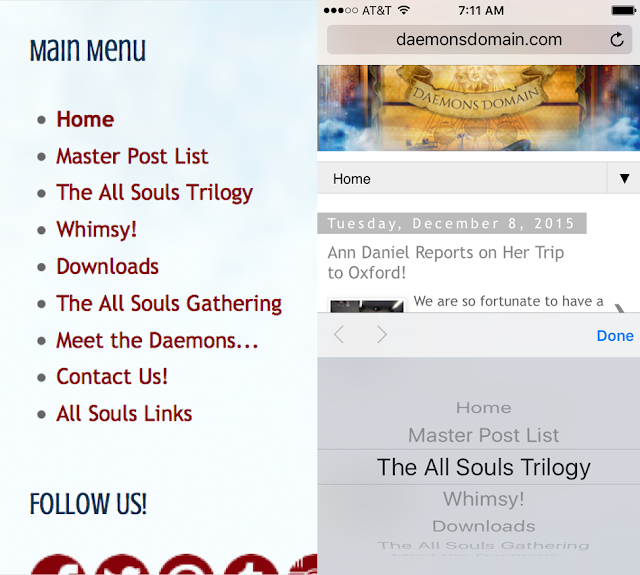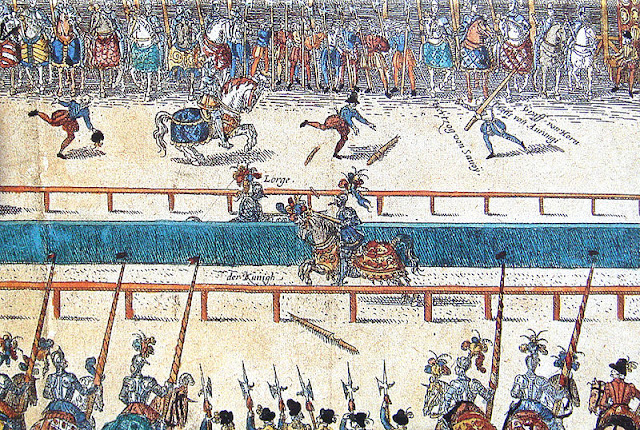 |
| There she is...The Big Apple! |
We consider ourselves always learning – perpetual students, if you will. So when an opportunity for a field trip presents itself, we take it! This excursion took shape in the form a big apple – or rather the Big Apple!
(Sure we could talk about the apple, Diana’s unfortunate walk in the garden at Sept-Tours, but that’s another delve for another time.) So, what does the
All Souls Trilogy and New York City have in common? A whole lot more than you think -- an incredible amount of items that are or could be in the de Clermonts’ – namely Matthew’s – possession are at some of the finest museums in Manhattan.
First, touchdown at La Gaurdia Airport – ala Matthew and Diana in
A Discovery of Witches. (First-class was the best we could do until Baldwin invites us to travel on his jet.)
“I didn’t wake until we landed at La Guardia…”
~ A Discovery of Witches (Truthfully, this Daemon hadn’t either.)
No time to waste – off to The Morgan Library and Museum1!
There are various exhibits on display throughout The Morgan Library and Museum (“ML&M”), but it was a mission to head straight for – you guessed it – the Library! It is a Pierpont Morgan’s (aka J.P. Morgan, American financier and banker) 1906 library in a preserved state. The Library is by far the largest and grandest of the rooms there. The walls reach to a height of thirty feet and are lined floor to ceiling with triple tiers of bookcases fashioned of bronze and inlaid Circassian walnut. (Tell us that doesn’t sound de Clermont-like?!)
The immediate sight of the East Room (“the Library”) at ML&M is breathtaking! Although the de Clermonts have had centuries to amass loads of artifacts and valuables, this collection certainly reminded us of one that may meet the approval of Matthew, if not Phoebe!
 |
| One wall of the Pierpont Morgan’s 1906 library |
What All Souls Trilogy and Matthew-like items were inside? Let’s cut to the chase:
As in Matthew’s own library at Sept-Tours, there was a copy of the Gutenberg Bible on display. (We’ll admit, Matthew is a bit more discreet!) The ML&M is the only institution in the world to own three copies of the Gutenberg Bible (one on vellum and two on paper). Only around fifty copies - maybe 51 if you count Matthew’s ;) – exist today, when there were only around 160–180 copies ever produced in the 1450s!
In
A Discovery of Witches, Diana remarks: “I absolutely refuse to treat a Gutenberg Bible as a reference book, Matthew.” We feel you Diana! The Morgan's copy is spectacularly preserved, but we feel like a whisper could force deterioration upon it.
 |
Biblia Sacra Latina, Mainz: Johann Gutenberg and Johann Fust, 1455
This is the second volume of one of Morgan’s paper copies. |
 |
| The image on the left shows the gilt edges of the Bible, and the right image shows a close-up of the text. |
These are just a few Gutenberg images, but if you’d like to see ML&M’s own digital images of their Old Testament copy along with commentary on its history and significance, go
here.
Moving along the room, there is a glass case that houses several brilliantly illuminated manuscripts.
Book of Hours anyone? Right this way…
The
Book of Hours is a Christian devotional book from the Middle Ages. Each manuscript is unique in one way or another but most share in common a collection of texts, prayers and psalms, often with appropriate decorations, for Christian devotion. Illumination or decoration is minimal in many examples, often restricted to decorated capital letters at the start of psalms and other prayers, but books made for wealthy patrons (like Queen Elizabeth I and possibly someone like Matthew de Clermont) were sometimes extremely lavish, with full-page miniatures.
Just one look at this illuminated manuscript reminded us of Diana examining Ashmole 782: “The colors were luminous and strikingly well preserved. Artists had once mixed crushed stone and gems into their paints to produce such powerful colors. And the image itself had been drawn by someone with real artistic skill. ”
~ A Discovery of Witches
Examples:
 |
| Exhibit 1: The Book of Hours in Latin and French (Paris, France ca. 1460) Illuminated by a Follower of the Master Jean Rolin II |
 |
| On the left you can see where the gilt in the illumination catches the light. On the right you see the ornate clasp. |
 |
| Exhibit 2: Book of Hours: Warwick-Psalter Hours, Sarum in Latin / England for Henry Beauchamp, Earl of Warwick 1430-45 with additions made in Ferrera, Italy 1482 by Alessandro Leoni |
 |
| Exhibit #3: Hours of Don Alfonso de Castile, Rome use in Latin / Spain for Don Alfonso (brother of Queen Isabella) ca. 1465-1475, from workshop of Juan de Carrión |
As
jaws continued to drop browsing continued, the spying of a certain book immediately brought Gallowglass to mind!
Only the museum can truly give the description justice, but many All Souls readers will giggle upon seeing “All For One! One For All!” (and then silently add…
“and all that jazz.” aaaand maybe think of the less than polite term Gallowglass used to refer to the Musketeers.)
Striking Medieval and Renaissance books and manuscripts aren’t the only treasures in Mr. Morgan’s magnificent collection though.
Classical music plays (no pun intended!) across the
All Souls Trilogy and most prominently in
The Book of Life - so this Daemon was delighted to come across the sheet music and manuscript pages of Mozart, Brahms, and Beethoven on this excursion – all who have been mentioned or featured in the trilogy.
The Morgan Library's collection of classical, popular, and folk music includes autograph scores, composers' letters, printed music, and other printed materials. The Morgan houses the largest collection of Mahler manuscripts anywhere as well as substantial holdings of Brahms, Chopin, Debussy, Mozart, Schubert, and Richard Strauss. The collection spans six centuries and many countries.
“Stop thinking and listen,” he commanded. “It’s impossible to be tense around Mozart.”
~ A Discovery of Witches
 |
Wolfgang Amadeus Mozart (1756-1791) Sonata for violin and piano in F major, K. 376, 1781
(sample of music) |
“There was an ancient stereo there and enough Brahms to muffle the lengthiest of conversations.”
~ The Book of Life
 |
Johannes Brahms (1833 – 1897) Symphony No. 2 in D Major, op 73, 1877
(sample music) |
“Jack was invited to join Matthew and to bring his cello with him. He played Beethoven for hours on end, and not only did the music have positive effects on my husband, it unfailingly put my daughter to sleep as well.”
~ The Book of Life
 |
Ludwig van Beethoven, Violin Sonata no. 10 in G Major. Autograph manuscript, 1815
(sample music) |
Taking one more sweep over the room, there are books as far as the eye can see, but above the fireplace, there is a beautiful Renaissance wall hanging. Weaving is the cornerstone of the
All Souls Trilogy, and tapestries are mentioned in the literal and figurative senses -- especially in
Shadow of Night.
This particular tapestry hangs above the mantelpiece on the east wall of the Library. “This grand piece is titled
“The Triumph of Avarice”, with a moralizing Latin inscription that translates, ‘As Tantalus is ever thirsty in the midst of water, so is the miser always desirous of riches.’ The tapestry belongs to a series depicting the Seven Deadly Sins, designed by Pieter Coecke van Aelst (1502–50). It was later produced in a Brussels workshop."
Being Daemons, we like to take a flight of fancy now and again. Here’s how
we fantasize it loosely tied to the
All Souls series: A set of the Seven Deadly Sins panels was woven for Cardinal Thomas Wolsey (Henry VIII’s chief advisor) to display at Hampton Court Palace. We like to imagine that Sebastian St. Clair (who we hope to see in The Serpent's Mirror!) visited on occasion and may have taken a glimpse of it! At the very least,
we were certainly tempted to take a peek to see if any undiscovered telescopes or other anomalies were hiding behind it! ;) (You just never know where Philippe sent Gallowglass on “errands”!)
 |
| The Triumph of Avarice tapestry |
There are many more stunning artifacts and structures in the study, rotunda and other exhibits of the museum so if you are ever in the city, we highly recommend you visit the library and museum to see it in its entirety. You can go on your own
All Souls scavenger hunt (e.g. William Blake Collection incl. The Tyger, Crusader Bible, reliefs of antiquities, etc.). Just as Shadow of Night closes with William Shakespeare, be sure to bid adieu to him before departing The Morgan Library and Museum. Later, Will!
1. A quick history lesson “About” the Morgan Library and Museum: It is “A complex of buildings in the heart of New York City, The Morgan Library & Museum began as the private library of financier Pierpont Morgan (1837–1913), one of the preeminent collectors and cultural benefactors in the United States. As early as 1890 Morgan had begun to assemble a collection of illuminated, literary, and historical manuscripts, early printed books, and old master drawings and prints.”
Links to check out:
360° view of The Morgan Library (courtesy of Bruno Viégas de Barros on Instagram)
www.themorgan.org/about/introduction
www.themorgan.org/research/guides/music-manuscripts-and-printed-music
http://www.themorgan.org/about/architectural-history/5
Until next time...
 (Specifically, the Maven Daemon today!)
Follow us on Facebook - Twitter - Pinterest - Tumblr - Instagram - Subscribe
(Specifically, the Maven Daemon today!)
Follow us on Facebook - Twitter - Pinterest - Tumblr - Instagram - Subscribe






































